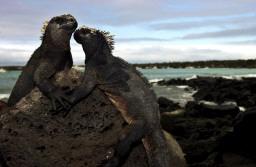Italian biologists working on the Galapagos Islands have identified a pink-and-black striped iguana they claim Charles Darwin failed to spot during his visit to the volcanic archipelago in 1835.
Darwin, who developed his theory of evolution after studying the islands' endemic species, missed the pink iguana because he did not visit its only habitat - the active Wolf volcano on Isabela, the archipelago's largest island, the biologists said.
Valerio Sbordoni and Gabriele Gentile of Rome's Tor Vergata University said that analysis of the iguana's mitochondrial DNA shows that the species is some five million years old, first appearing when many of the Galapagos islands were not yet even formed.
The researchers said that comparisons with the DNA of other species revealed that the pink iguana had to be placed at the base of the genealogical tree for terrestrial iguanas.
Further research was needed to reconstruct the evolutionary history of iguanas in light of the evidence, they added.
''But immediate efforts are required to safeguard this species we have identified and to prevent it from becoming extinct,'' they said.
Although a ranger from the national park first caught a glimpse of the reptile in 1986, this is the first time it has been studied.
Sbordoni and Gentile's research has been published in American journal Proceedings of the National Academy of Sciences.
This year marks the 150th anniversary of Darwin's On The Origin of Species, a landmark work in evolutionary biology.










